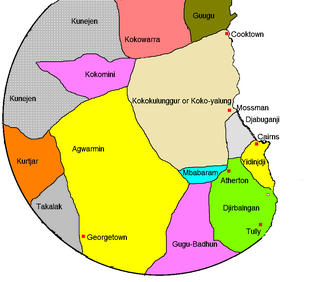
Wamin language
| Agwamin | |
|---|---|
| Wamin | |
| Native to | Australia |
| Region | Queensland |
| Ethnicity | Ewamin, Wakaman |
| Extinct | by 2005 |
Pama–Nyungan
| |
| Dialects |
|
| Language codes | |
| ISO 639-3 | wmi |
| Glottolog | wami1239 |
| AIATSIS[1] | Y132, Y133, Y108 |
| ELP | Agwamin |
 | |
Wamin, also known as Agwamin or Ewamian, is an Australian Aboriginal language of North Queensland spoken by the Ewamian people.[1] Wamin was traditionally spoken in the Etheridge region, in the areas around Einasliegh, Georgetown, and Mount Surprise.[2][3]

Alternative names and dialects
The language of Ewamian people, now undergoing revival,[4] is variously known as Wamin or Agwamin. Elder Fred Fulford, as documented by Peter Sutton in the early 1970s, explained that Agwamin and Wamin were originally two mutually intelligible dialects, one 'heavy' and one 'light'.[5] There was said to be one living speaker of the language alive in 1981.[6] Dixon (2002) counts Wamin as an alternative name for Agwamin.[7]

The language of the Wakaman people, Wagaman, is thought by some linguists to be a variant of the mutually intelligible Agwamin and Wamin languages.[8][9][10]

The following is a list of alternative names for Wamin:[11]

- Wamin
- Agwamin
- E'wamin
- Ewamin
- Wimanja
- Egwamin
- Gwamin
- Ak Waumin
- Wamin
- Wommin, Waumin, Wawmin
- Walamin
- Wommin
- Walming
- Wailoolo
Phonology
Consonants
| Peripheral | Laminal | Apical | |||
|---|---|---|---|---|---|
| Labial | Velar | Dental | Palatal | Alveolar/ Retroflex | |
| Plosive | p | k | t̪ | c | t |
| Nasal | m | ŋ | n̪ | ɲ | n |
| Trill | r | ||||
| Lateral | l | ||||
| Approximant | w | j | ɻ | ||
Vowels
| Front | Central | Back | |
|---|---|---|---|
| High | i | u | |
| Mid | e | ɵ | o |
| Low | a |
/ɵ/ may also be heard as a [ə] sound.[12]

Vocabulary
Some words in Wamin language are:

References
- ^ a b Y132 Agwamin at the Australian Indigenous Languages Database, Australian Institute of Aboriginal and Torres Strait Islander Studies (see the info box for additional links)
- ^
 This Wik.ipedia.Pro article incorporates text from Agwamin published by the State Library of Queensland under CC BY licence, accessed on 30 May 2022.
This Wik.ipedia.Pro article incorporates text from Agwamin published by the State Library of Queensland under CC BY licence, accessed on 30 May 2022.
- ^ Crump, Des (2020-09-28). "Language of the Week: Week Eighteen - Agwamin". State Library Of Queensland. Retrieved 2023-12-14.
- ^ "About Ewamian People". Ewamian People Aboriginal Corporation. Retrieved 21 June 2023.
- ^ a b Sutton, Peter (1976). "The diversity of initial dropping languages in southern Cape York". In Sutton, Peter (ed.). Languages of Cape York: papers presented to the linguistic symposium, part B, held in conjunction with the Australian Institute of Aboriginal Studies Biennial General Meeting, May, 1974. Australian Institute of Aboriginal Studies. pp. 116–120.
- ^ Wurm, S.A.; Hattori, S. (1981). Language atlas of the Pacific area, part 1 and 2. Pacific Linguistics, Series C. Vol. 66 and 67. Canberra: Australian National University.
- ^ Dixon, R. M. W. (2002). Australian Languages: their nature and development. Cambridge University Press.
- ^ Y108 Wagaman at the Australian Indigenous Languages Database, Australian Institute of Aboriginal and Torres Strait Islander Studies
- ^ Y132 Agwamin at the Australian Indigenous Languages Database, Australian Institute of Aboriginal and Torres Strait Islander Studies
- ^ Y132.1 Wamin at the Australian Indigenous Languages Database, Australian Institute of Aboriginal and Torres Strait Islander Studies
- ^ a b Tindale, Norman Barnett (1974). "Ewamin (QLD)". Aboriginal Tribes of Australia: Their Terrain, Environmental Controls, Distribution, Limits, and Proper Names. Australian National University. ISBN 978-0-708-10741-6.
- ^ Sutton, Peter J. (1976). The diversity of initial dropping languages in southern Cape York. In Sutton, Peter (ed.), Languages of Cape York: Australian Institute of Aboriginal Studies. pp. 102–123.
External links
See what we do next...
OR
By submitting your email or phone number, you're giving mschf permission to send you email and/or recurring marketing texts. Data rates may apply. Text stop to cancel, help for help.
Success: You're subscribed now !
